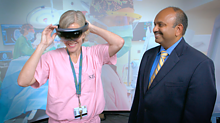MBRC Team Wins Invention of the Year Award

A team of computer scientists and clinicians from the Maryland Blended Reality Center (MBRC) has won the University of Maryland’s Invention of the Year award in the information sciences category.
The award, presented April 11 at the annual Innovate Maryland event, honors exceptional inventions in three categories—physical, information and life sciences—that have the potential to influence science, society and the free market.
Accepting the Invention of the Year award were team members Amitabh Varshney, professor and dean of UMD’s College of Computer, Mathematical, and Natural Sciences; Dr. Sarah Murthi, an associate professor of surgery at the University of Maryland, Baltimore; Dr. Gary Schwartzbauer, an assistant professor of surgery at UMB; and Xuetong Sun, a computer science doctoral student at UMD.
The MBRC researchers are developing a system that uses augmented reality (AR) to assist physicians in the placement of an external ventricular drain (EVD), a common—yet sometimes risky—procedure used to relieve the build-up of cerebrospinal fluid in the brain.
EVDs are often used in emergency medicine when a person has suffered serious head trauma. The procedure requires the insertion of a small catheter into the ventricle, a small cavity in the brain filled with fluid, allowing for the drainage of excess fluid and the monitoring of intercranial pressure.
Currently, surgeons are not able to “see” how a catheter is entering the ventricle during an EVD placement. They instead must rely upon their experience and knowledge of human anatomy to blindly guide the placement of the catheter’s needle. Any small error can bring a risk of serious medical complications.
The MBRC team is building an AR system that provides an accurate virtual representation of the catheter’s tip inside the human skull. Wearing an AR headset, a surgeon is able to virtually “see” both the location of the catheter’s tip and also see important patient data available from a computer tomography (CT) scan.
The technology is intended to reduce procedural errors and offer emergency physicians quick access to important diagnostic data directly in their field of view.
In addition to their teaching roles at the University of Maryland School of Medicine, Drs. Murthi and Schwartzbauer practice emergency medicine at the renowned R Adams Cowley Shock Trauma Center in Baltimore, where Murthi is a trauma surgeon and Schwartzbauer is a neurosurgeon.
The Baltimore physicians have been working with computer visualization experts at UMD for several years, with initial support coming from The University of Maryland Strategic Partnership: MPowering the State. The MPower initiative was launched in 2012 to incentivize research, education and innovation between the state’s top public research universities: the University of Maryland, College Park, and the University of Maryland, Baltimore.
The MPower collaboration has already resulted in the MBRC team building an ultrasound imaging prototype that uses AR to overlay important diagnostic information directly on the patient.
This earlier research led to the current EVD project.
